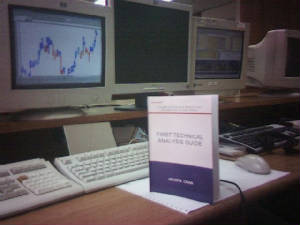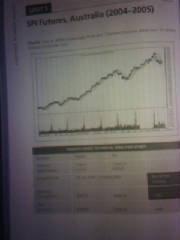|
Methodology - Developing a Trading System
Step by Step
Data Analysis - The first step is to obtain
the data. Depending on the time series, historical data of 120 to 1,000 is required. Usually, for comparison purposes,
the standard 250 most current data is used.
Trading Tools - The common trading tools are moving averages and convergences
and divergences. There are many tools available, some are leading indicators like RSI and Stochastics, some are lagging
indicators like moving averages and MACD. Example: In Metastock programme, under 'Analysis',
pull down "Moving Average' and specify the number of periods (usually the default is 20). With the moving average line
moving through the prices , the trader can define uptrend as when prices are above the moving average line and downtrend as
below the moving average prices.
The weakness to this moving average system is that it tries to define trends all the
time which may not be true because a good percentage of the time it is confined to range trading.
Another indicator is necessary to differentiate range from trend trading. X percentage from
the moving average is one indicator. BBZ is
a proprietary trading model that define trend from range trading.
Trading Technique - The most important technique is to recognise a trend. The
trading rules are when to buy and when to sell. In a simple moving average model, the trading rules are to buy when
price is above the moving average and to sell when price is below the moving average. In a percentage from moving
average, the trading rules are: to buy long when price is above the X percentage from
the moving average, sell to exit long when the price comes back within the X percentage upper band and to sell short when
price is below the X percentage from the moving average, buy to exit short then the price comes back with the X percentage
lower band. BBZ works under this same concept. Note that in this way, there is no need to trade all
the time.
Mathematical Formula- if the trading system involves indicators, the mathematical
calculation can be done on excel worksheet. Example: for a 3 day moving average, enter in: Column
A: Date; Column B: Close, Column C: Moving Average (=average(B2:B4), Column D: Buy Signal (B4>C4), Column E: Sell Signal
(B4<C4).
To differentiate trend trading from range trading, for BBZ, additional sets of mathematical
calculation is required.
Mechanical Trading System - all mechanical trading systems must be quantifable
and they involve no human judgement. BBZ is a purely mechanical trading system. Example:
In MetaStock, under system tester, we can run simulation tests for backtesting BBZ. The results for the period 2/1/2004
to 31/1/3/2004 are as follows:
Trading Plan - The most important consideration
is the permissible risk - how much the trader is willing to lose on entry of the trade. The second important
consideration is expected return. The rule of thumb is the expected return must be X times larger than the permissible
loss.
Risk Management - This is all about cutting loss early. This stop loss
order should be automatic and placed at the time of the entry of the trade. This means that the trader knows
what is his maximum loss the moment he enters the trade.
Capital Requirement - This variation margin should be able to cover/withstand
the maximum losses incurred consecutively.
Trade Evaluation Record - The final step is to record each and every trade
and then carefully evaluate what went right and what went wrong. This is to compare the actual return versus the
expected return and the actual loss versus the permissible loss. This is check for discipline in the trader
and also to fine tune on his projection skills.
Trading Attitude - This is the characteristic that determines long
term winners and distinguishes them from everyday losers. Long term winners understand that the expectation
to win is only 50% chance and he will keep on linear trading,cutting small loss after small loss, until he makes profit
from the big trend from the extended period of accumulation or distribution. This is because they follow their
trading plan. Losers give up after 1st, 2nd, 3rd etc attempt especially when they do not follow any trading plan
and refuse to cut loss. They will know they are losers when they are forced to cut loss when all their margins have
been depleted.

FIRST TECHNICAL ANALYSIS GUIDE is also available at First Edition Bookstores
Next
|
 |
|
Summation
In order to claim and prove that BBZ is a profitable trading system, tests must also be done
on other products, traded on other exchanges. Below is a profit table of results for FCPO (Malaysia), Hang Seng Index
Futures (Hong Kong) and Nikkei Index Futures (Singapore) for the same sample period of 2/1/2004 to 31/12/2004.

Live Trading Issues to consider
The results we have discussed so far are from backtesting.
There are a few differences between the profits from live trading and the results from back testing. The differences
are:
1) Slippage (because of thin market conditions)
2) Intraday whipsaws (market may touch trigger price and then retrace back)
3) Extra rollover costs (when the current month expires, it is necessary to rollover to the
next month if the trade signal is still on)
4) Rollover points
5) Earlier entries and exits
While slippage, intraday whipsaws and extra rollover tansaction costs may result in less profit
than that from backtesting, the rollover points may sometimes bring gains not recorded in back testing.
Back testing uses the closing price whereas in live trading, we will enter into positions immediately
when we get the signal. This could result in more gain or less loss as the closing price is not usually the entry or
exit price and is usually worse thatn the entry or exit price,
We conduct a 4 part series of Trading for a Living seminars
on a regular basis.
Trading for a Living Course:
F2011:
Introduction to the Basics of Technical Analysis
F2012:
Applying Technical Analysis to Charts and Trading
F2013:
Professional Trading Model
F3002:
Passing Examinations to be a Trader
For more information on our TFL seminars, please give us
your name and email address.
Professional Technical Trading Systems
|
THE COMPLETE COURSE FROM BEGINNER TO PROFESSIONAL LEVEL
|
IN HOUSE TRAINING MAY BE ARRANGED
This is the complete, hands-on practical technical analysis course to become a professional trader.

|
|
|
|
|
|
|


